There has been much chatter in the agricultural community about the Farm Bill which was recently signed into law. The final version of the Farm Bill was identified as the Agriculture Act of 2014. This version was a compromise between the House and Senate versions which were several years in development. The Farm Bill is a comprehensive spending measure that combines diverse, seemingly unrelated, budget items. However, the new law deals with agriculture and all items under the purview of the United States Department of Agriculture (USDA).
 This extensive law sets policy for government farm subsidies and nutrition programs including food stamps. It also funds the USDA and associated programs including conservation, international food aid and rural development. The costs are expected to be $96 billion annually with almost 80% of this going to food stamps or the Supplemental Nutrition Assistance Program (SNAP). About 15% of the costs will go towards farm and crop insurance subsidies, the second largest category of expenditures.
This extensive law sets policy for government farm subsidies and nutrition programs including food stamps. It also funds the USDA and associated programs including conservation, international food aid and rural development. The costs are expected to be $96 billion annually with almost 80% of this going to food stamps or the Supplemental Nutrition Assistance Program (SNAP). About 15% of the costs will go towards farm and crop insurance subsidies, the second largest category of expenditures.
The overall savings compared to the 2008 Farm Bill is about $1.65 billion annually which was a challenging compromise between House and Senate versions. The new law eliminated farm subsidies called “direct payments” which cost about $4.5 billion per year. Most of those savings were moved into expanded crop insurance programs which form the safety net for agriculture. Agriculture is a challenging industry affected by market fluctuations, weather, and natural disasters such as disease outbreaks or freezes which can severely impact production in any given year or location. Lawmakers argue these programs are in place because the national and world food supply is dependent on farmers staying in business.
The greatest issue of local agricultural importance is that the law recognizes established “base acres” as those eligible for certain crop insurance programs. However, only base acres which were established prior to 2002 were recognized as eligible to participate in those insurance programs. This base is tied to the land, and only applied to land used for the production of eligible commodities prior to 2002. Therefore, new farmers and farmland in our area are ineligible for participation in these new programs. Essentially these new farmers large and small are on the outside looking in. This is particularly important to cotton and peanut programs which are so important to the ag economy in this region.
The “rules and regulations” as it pertains to the new law have not been completed. However, here at UF/IFAS Extension we are working to deliver the latest information as it becomes available. We will have representatives from the USDA discuss the latest interpretation of the law as it affects area farmers at our upcoming Peanut Production Meeting on March 6 and the Cotton Production Update on March 27th.
